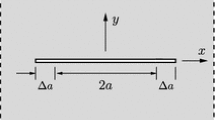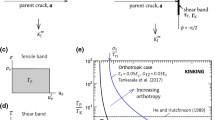Abstract
In the context of linear elasticity, a stress singularity of the type Knrδ(δ<0) may exist at sharp re-entrant corners, with an intensity Kn. In general the order of the stress singularity δ and the stress intensity differ for symmetric (mode I) and antisymmetric (mode II) loading. Under general mixed-mode loadings, the magnitudes of the mode I and II intensities fully characterize the stress state in the region of the corner. A failure criterion based on critical values of these intensities may be appropriate in situations where the region around the corner dominated by the singular fields is large compared to intrinsic flaw sizes, inelastic zones, and fracture process zone sizes. We determined the mode I and II stress intensities for notched mode I tensile specimens and notched mode II flexure specimens using a combination of the Williams (1952) asymptotic method, dimensional considerations, and detailed finite element analysis. We carried out a companion experimental study to extract critical values of the mode I and II stress intensities for a series of notched polymethyl methacrylate (PMMA) tensile and flexure specimens with notch angles of 90-. The data show that excellent failure correlation is obtained, in both mode I and II loading, through the use of a single parameter, the critical stress intensity. We then analyzed and tested a series of T-shaped structures containing 90- corners. The applied tensile loading results in mixed-mode loading of the 90- corners. Failure of the specimens is brittle and can be well-correlated with a critical mode I stress intensity criterion using the results of the notched mode I tensile tests. This is attributed to large difference in the strength of the stress singularities in modes I and II: δ= -0.4555 and -0.0915 for modes I and II for a 90- notch. As a result, the mode I loading dominates the failure process for the 90- corner in the T-structure.
Similar content being viewed by others
References
Benthem, J.P. (1963). A Laplace transform method for the solution of semi-infinite and finite strip problems in stress analysis. Quarterly Journal of Mechanical Applied Mathematics 16, 413–429.
Berry, J.P. (1961). Journal of Polymer Science 50, 107–115.
Carpenter, W.C. (1984). Calculation of fracture parameters for a general corner. International Journal of Fracture 24, 45–58.
Carpenter, W.C. (1984a). A collocation procedure for determining fracture mechanics parameters at a corner. International Journal of Fracture 24, 255–266.
Carpenter, W.C. (1985b). Mode I and mode II stress intensities for plates with cracks of finite opening. International Journal of Fracture 26, 201–214.
Carpenter, W.C. (1985). The eigenvector solution for a general corner of finite opening crack with further studies on the collocation procedure. International Journal of Fracture 27, 63–74.
Carpinteri, A. (1987). Stress-singularity and generalized fracture toughness at the vertex of re-entrant corners. Engineering Fracture Mechanics 26, 143–155.
Dempsey, J.P. and Sinclair, G.B. (1981). On the singular behavior at the vertex of a bimaterial wedge. Journal of Elasticity 11, 317–327.
Dunn, M.L., Suwito, W. and Cunningham, S.J. (1997). Fracture initiation at sharp notches: correlation using critical stress intensities. International Journal of Solids and Structures, in press.
Gross, B. and Mendelson, A. (1972). Plane elastostatics of V-notched plates. International Journal of Fracture Mechanics 8, 267–276.
Gu, L. and Belytschko, T. (1994). A numerical study of stress singularities in a two-material wedge. International Journal of Solids and Structures 31, 865–889.
Higuchi, M. (1958). Reports of Research, Institute for Applied Mechanics, Kyushu University 6, 173–179.
Knesl, Z. (1991). A criterion of V-notch stability. International Journal of Fracture 48, R79–R83.
Leicester, R.H. (1973). Effect of size on the strength of structures. CSIRO Forest Products Laboratory, Division of Building Research, Paper no. 71.
Pageau, S.S., Joseph, P.F. and Biggers, S.B. (1995). A finite element analysis of singular stress fields in anisotropic materials loaded in antiplane shear. International Journal for Numerical Methods in Engineering 38, 81–97.
Palaniswamy, K. and Knauss, W.G. (1972). Propagation of a crack under general in-plane tension. International Journal of Fracture Mechanics 8, 114–117.
Reedy, E.D., Jr. (1990). Intensity of the stress singularity at the interface corner between a bonded elastic and rigid layer. Engineering Fracture Mechanics 38, 575–583.
Reedy, E.D., Jr. (1991). Intensity of the stress singularity at the interface corner of a bonded elastic layer subjected to shear. Engineering Fracture Mechanics 38, 273–281.
Reedy, E.D., Jr. (1993). Asymptotic interface corner solutions for butt tensile joints. International Journal of Solids Structures 30, 767–777.
Reedy, E.D., Jr. (1993). Free-edge stress intensity factor for a bonded ductile layer subjected to shear. Journal of Applied Mechanics 60, 715–720.
Reedy, E.D., Jr. and Guess, T.R. (1993). Comparison of butt tensile strength data with interface corner stress intensity factor prediction. International Journal of Solids Structures 30, 2929–2936.
Reedy, E.D., Jr. and Guess, T.R. (1995). Butt tensile joint strength: interface corner stress intensity factor prediction. Journal of Adhesion Science Technology 9, 237–251.
Reedy, E.D., Jr. and Guess, T.R. (1996). Butt joint strength: effects of residual stress and stress relaxation. Journal of Adhesion Science Technology, in press.
Ritchie, R.O., Knott, J.F. and Rice, J.R. (1973). On the relationship between critical tensile stress and fracture toughness in mild steel. Journal of Mechanical Physics Solids 21, 395–410.
Seweryn, A. (1994). Brittle fracture criterion for structures with sharp notches. Engineering Fracture Mechanics 47, 673–681.
Seweryn, A. and Mroz, Z. (1995). A non-local stress failure condition for structural elements under multiaxial loading. Engineering Fracture Mechanics 51, 955–973.
Sinclair, G.B. (1985). A remark on the determination of mode I and II stress intensity factors for sharp re-entrant corners. International Journal of Fracture 27, R81–R85.
Sinclair, G.B., Okajima, M. and Griffin, J.H. (1984). International Journal for Numerical Methods in Engineering 20, 999–1008.
Sukumar, N. and Kumosa, M. (1992). Application of the finite element iterative method to cracks and sharp notches in orthotropic media. International Journal of Fracture 58, 177–192.
Ting, T.C.T. (1986). Explicit solution and invariance of the singularities at an interface crack in anisotropic composites. International Journal of Solids Structures 22, 965–983.
Ting, T.C.T. (1996). Anisotropic Elasticity: Theory and Applications, Oxford University Press.
Ting, T.C.T. and Chou, S.C. (1981). Edge singularities in anisotropic composites. International Journal of Solids Structures 17, 1057–1068.
Vasilopoulos, D. (1988). On the determination of higher order terms of singular elastic stress fields near corners. Numerical Mathematics 53, 51–95.
Walsh, P.F. (1974). Linear fracture mechanics solutions for zero and right angle notches, CSIRO Forest Products Laboratory, Division of Building Research, Paper no. 2.
Walsh, P.F. (1976). Crack initiation in plain concrete. Magazine of Concrete Restoration 28, 37–41.
Williams, M.L. (1952). Stress singularities resulting from various boundary conditions in angular corners of plates in extension. Journal of Applied Mechanics 74, 526–528.
Williams, J.G. (1984). Fracture Mechanics of Polymers, Ellis Horwood, Chichester.
Author information
Authors and Affiliations
Rights and permissions
About this article
Cite this article
Dunn, M.L., Suwito, W., Cunningham, S. et al. Fracture initiation at sharp notches under mode I, mode II, and mild mixed mode loading. International Journal of Fracture 84, 367–381 (1997). https://doi.org/10.1023/A:1007346203407
Issue Date:
DOI: https://doi.org/10.1023/A:1007346203407




